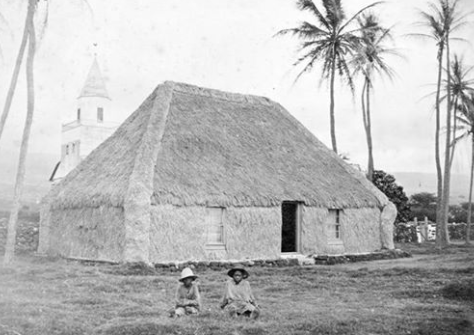Grass House
Joseph Makaʻai talks about living with
his grandparents in a hale pili

A listen and read along experience
In our Mānaleo Series, we provide short clips of a native speakers recorded on Ka Leo Hawaiʻi talking about an interesting experience or sharing knowledge. Below the clip is the transcript and a translation, so you can follow along as you listen. Play the clip multiple times and read along in either language. Our mahalo goes out to Larry Kimura for his work on Ka Leo Hawaiʻi and in building one of the most important archives we have of native speakers of ʻōlelo Hawaiʻi.
Directions
1. Press play on the video below (make sure the volume is up).
2. Scroll down and read along in Hawaiian.
3. Scroll back up and play the video again.
4. Read along in English.
5. Repeat as many times as needed.
Kikokikona - Transcript
Makaʻai: Ka inoa o koʻu kupunahine, ʻo ia hoʻi ʻo Kahiko. Ka inoa o koʻu kupunakāne, ʻo ia hoʻi ʻo Mahikō.
Kimura: Na lāua nō i mālama iā ʻoe a…
Makaʻai: ʻAe. Mālama iaʻu mai koʻu wā liʻiliʻi a nui, kanaka makua aʻela au. He hale mauʻu ko mākou manawa, koʻu kupunahine, me kēlā nō hoʻi me koʻu kupunakāne a noho nō au i loko o kēia hale mauʻu.
Kimura: He hale pili.
Makaʻai: Hale pili.
Kimura: Pehea ka noho ʻana o loko o kēia ʻano hale? He…
Makaʻai: ʻAno mahana nō ke ʻoe noho i loko o kēia hale. But, ke ʻoe - you know, maʻemaʻe nō. No ka mea, ka hāliʻiliʻi i ka moena, ua hana ʻia nō hoʻi a nui. ʻAʻole ʻeha ke ʻoe hiamoe.
Kimura: A he aha ka mea…
Makaʻai: Hāliʻiliʻi o lalo, ʻo ka pili, mauʻu pili.
Kimura: ʻO ke pili. A ma lalo aku o ke pili?
Makaʻai: Ma lalo o ka pili a hāliʻi ʻia mai kēia ʻiliʻili. Hele i ka lae kahakai e kiʻi i kēia ʻiliʻili liʻiliʻi
Kimura: Ma lalo aku o ka ʻiliʻili, he one?
Makaʻai: He one.
Kimura: He one nō?
Makaʻai: ʻAe.
Unuhina - Translation
Makaʻai: My grandmother’s name was Kahiko. My grandfather’s name was Mahikō.
Kimura: The two of them took care of you...
Makaʻai: Yes. They took care of me when I was small until I grew up and became an adult. In our time we had a grass house. My grandmother, her and my grandfather and I lived in a grass house.
Kimura: A house thatched with pili grass?
Makaʻai: Yes, a hale pili.
Kimura: What is it like living in a hale pili?
Makaʻai: It’s pretty warm when you are in there. But - you know, it’s clean. Because when you put down mats, you put down plenty. Then it’s not sore when you sleep.
Kimura: And what is...
Makaʻai: The layer underneath is pili, pili grass.
Kimura: Pili grass. And under the pili?
Makaʻai: Under the pili, pebbles are laid down. You go to the point at the ocean to get these pebbles.
Kimura: Under the pebbles is sand?
Makaʻai: Sand.
Kimura: It really is sand?
Makaʻai: Yes.
Ke lana nei ka manaʻo i ka hauʻoli o ka pepeiao a me ka naʻau i nā leo nahenahe o nā kupuna, kā kākou hoʻi o ka hoʻohiwahiwa ʻana i ka pule nei. Me ke aloha a me ka mahalo kākou e pani nei i ka hana o ka pule mua. A ma ke ʻano aloha hope, e hoʻonanea iki kākou i ka malu hale pili me ka leo o Joe Makaʻai. Ma kēia ʻano hale nō ʻo ia i hānai ʻia ai e kona mau kūpuna. ʻAʻole paha pinepine ko kākou lohe ʻana no ka hale pili a no laila ko mākou manaʻo e pani ai i ka pule nei me kēia pūʻolo leo hoʻohialaʻai.
Here we are at the end of this week of celebrating the voices of native speakers and we hope your ears and your naʻau are happy and full. As we finish out the week, we invite you to sit for a moment in the shade of the hale pili where Joe Makaʻai was raised by his kūpuna.
To access the full recording of Joe Makaʻai's conversation with Larry Kimura, click HERE.
